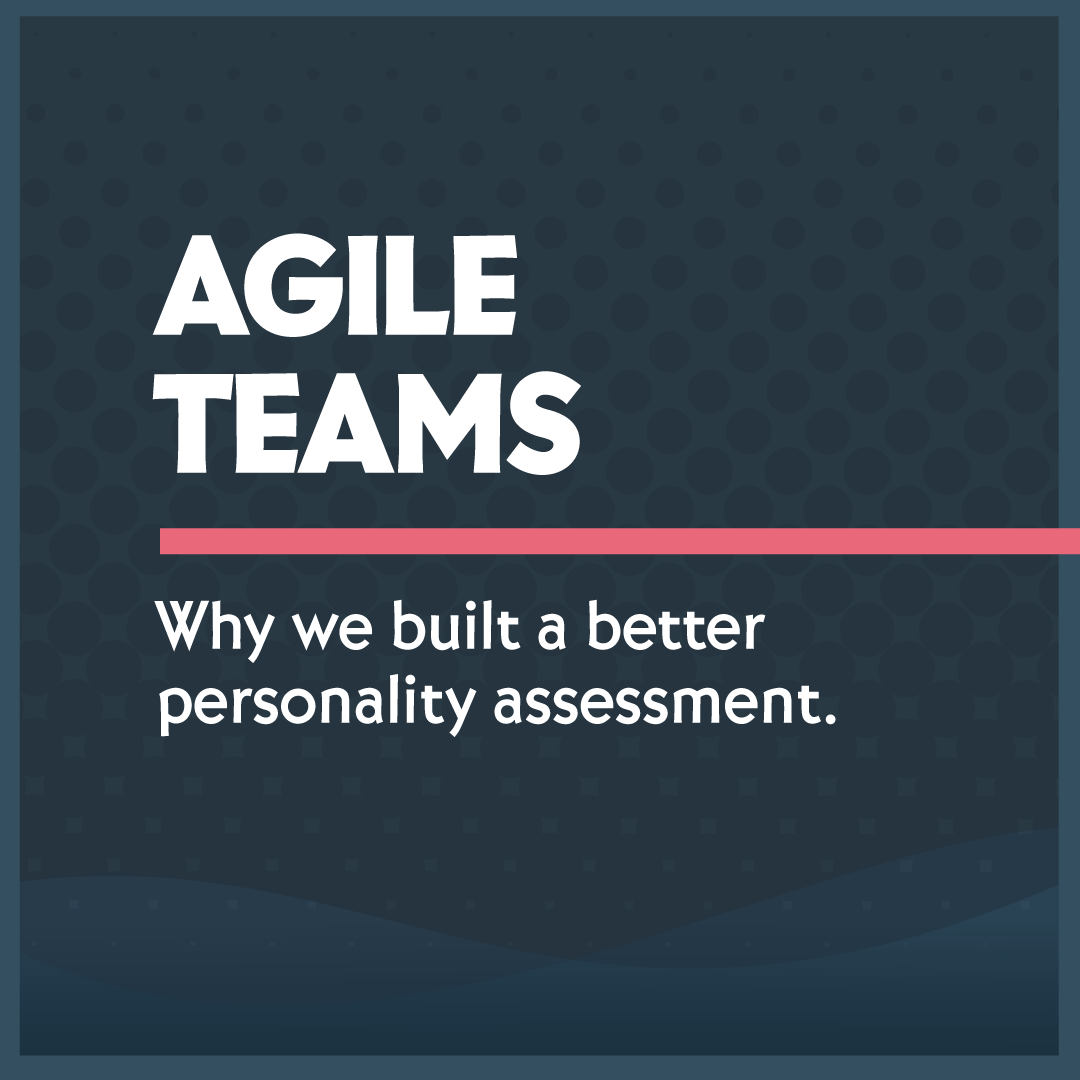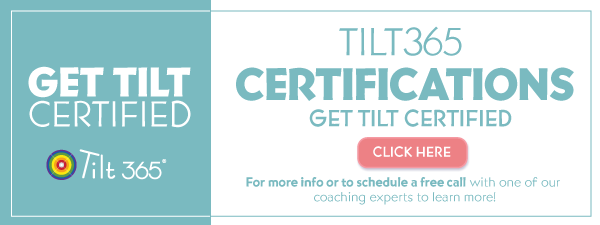Why We Built a Better Personality Assessment for Agile Teams

It’s no surprise that people who have spent time studying the traits of others are often more likely to have positive relationships. Luckily I was advised to learn more about this topic very early in my career after a particularly disappointing experience. I graduated from college and was finishing my first full year as a sales rep for a national home builder. At the conference, I won the Rookie of the Year Trophy for the highest volume of sales by a first-year associate. On our way home, a colleague told me that our Director of Sales was leaving to work for a competitor. My first thought was that the new opening meant a potential opportunity for a promotion in my career path. Given the award I’d just won, I assumed I would be a candidate for consideration.
 Much to my dismay, not only was I not even considered, my colleague got the job. Frustrated, I decided to visit the division leader and inquire about his reasons. As he explained, he handed me a book called “Please Understand Me” and told me that I should study it. He went on to say that I was one of the best new home sales reps he’d ever seen, but that if he promoted me to management, everyone would likely quit because my standards were too high. He added that he believed me to be an impressive individual contributor but predicted that I would never be a leader. And further, that if I learned about personalities, I would understand that.
Much to my dismay, not only was I not even considered, my colleague got the job. Frustrated, I decided to visit the division leader and inquire about his reasons. As he explained, he handed me a book called “Please Understand Me” and told me that I should study it. He went on to say that I was one of the best new home sales reps he’d ever seen, but that if he promoted me to management, everyone would likely quit because my standards were too high. He added that he believed me to be an impressive individual contributor but predicted that I would never be a leader. And further, that if I learned about personalities, I would understand that.
As I walked out of his office, I recalled taking a built-in assessment for personality for the organization called MBTI (Myers Briggs Type Indicator) and a graphology test (analyzing my handwriting) before hiring me. I began to wonder what these hiring tests told him about me. As I left his office, I went straight to HR and asked for my reports. Reading them, I could see how the results confirmed what he said, but the outcome didn’t sit well. I silently vowed to myself that I would prove him wrong one day. This moment would turn out to be the catalyst that triggered years of study regarding personality and leadership. Luckily, it proved to be profoundly useful too.
Five years later, in another industry, I was finally promoted to General Manager of a 35 million dollar luxury hotel. Two short years later, I was awarded the Chairman’s Award for Leadership in a company of 80,000 people. Today, I believe the consistent trait of tenacity in my character is what made the difference. I genuinely believe people can accomplish great things when we dare to be bold.
What’s the lesson in this story? It’s enormously helpful to understand what drives our personality. But it might be even more important to grow beyond the self-limiting ideas imposed by tools like these too. Fast forward several decades, and we’ve learned that brain plasticity is not only possible but probable in a global world that forces rapid growth on the modern leader. Personality is not only malleable; desirable behavior change can happen in as little as a few weeks. As the mind evolves to greater complexity, we are quite capable of moving beyond many inherited traits. In fact, we can develop new behaviors that better define our personality, purpose, and overall career trajectory.
A new kind of individual and team personality assessment
We set out to provide an agile assessment tool that could resolve the issues we had with existing self-awareness tools. With that goal in mind, we’ve spent the better part of a decade building a better personality assessment and positive influence feedback tools for individuals and teams in a work environment. The criteria we used to create them are perfect for integrative thinkers, and wicked-smart individual team members and organizations. We decided on 12 critical goals in developing Tilt365 to ensure product superiority and success in a world full of options:
- Beyond a Type: An agile assessment has to show people their unique inborn traits that were inherited, but use language that invites people to grow well beyond them. We’ve learned that agile personality characteristics will grow and mature with well-rounded character strengths.
- Memorable: It has to be simpler than other typology systems so that business leaders can remember it. Most business leaders don’t have time to memorize 16 types or 34 strengths. If they cannot remember it, they are less likely to apply it too.
- Visual Framework: One of the things we disliked about other agile assessments is that they used acronyms and very few visuals. Another factor in being memorable is that we wanted to link style patterns to a visual business model. Colorful visuals enable people to remember things with both their left and right brain centers.
- Positive: For the agile assessment tool to be effective, it would have to be strengths-based, so it offers encouragement and evidence that people can grow and change over time. As opposed to a focus on only mitigating problems, a positive psychology approach goes beyond being “not as bad” to excelling and flourishing.
- Actionable: Most personality assessments are mostly deterministic. Meaning, they tell you “this is who you are” and don’t encourage much more than minor modifications. Thus, we felt that a clear direction of development that balances the most extreme personality traits is essential to address the “what’s next” question that often arises. Personality modified by character choices is key to healthy development, continuous improvement, and transformation of an individual.
- Compelling: If the premise is that people are intelligent, then they need to know the underlying reasons for specific patterns and communication styles they may have developed. When a smart person knows why they do what they do, they are more likely to choose to change it.
- Rigorous Science: We noticed that the most popular personality assessments on the market were unreliable and had never accomplished much rigor in their validity. Even more concerning, and still valid today, managers make career-changing decisions using personality assessments that may not produce the same results a week later.
- Fast: We wanted to push the edge of modern scientific methods and build a highly reliable assessment tool that is fast enough to pass the short attention span of contemporary work life.
- Playful: Personality is personal, and changing well-worn patterns can be daunting. To make it easier, we decided that the approach had to be fun and playful. Our goal was to get people laughing at themselves and with each other, which would serve to improve teamwork.
- Reduce Biases: One of our biggest concerns was that we often don’t see ourselves clearly and need some input from others. But biases can be projected onto others with the “be like me” mindset. We built a second agile assessment that we designed to reduce biases from others while giving us valuable feedback about observations by others that we might miss in ourselves.
- Dynamic: To stand the test of time, we also wanted to design a suite of tools that grow with us over the years as our personality evolves with character strength development. It had to be highly actionable, help you see how much you’ve changed due to the context or role, and grow relationships by understanding the four most common patterns of behavior at work.
- A common language for teams: Last but not least, it had to use simple business language that applies to performance versus acronyms, colors, or obscure psychological terms that an expert has to explain.
A personality journey that grows with you
I am happy to say that great things can come from not-so-great experiences. Case in point, not getting a promotion many years ago was the fuel that has driven years of research and a strong drive to build a better personality assessment and a suite of tools to help people in business measure personality and grow as leaders.
Some of our best ideas may arise from our most painful experiences. This is also precisely the time we need to listen, learn, and be bold.




